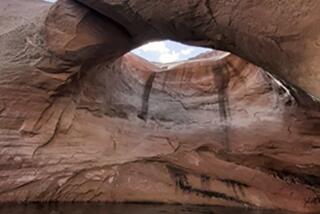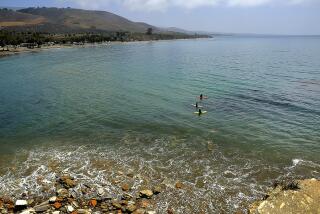Rising Waters Swallow a Paradise : The Great Salt Lake Engulfs Island State Park in Utah
- Share via
ANTELOPE ISLAND, Utah — Mitch Larson stood on Buffalo Point looking down at White Rock Bay, a dazzling white-sand beach embraced by the quietest of still water. The air was filled with a symphony of chirping birds. A dozen mule deer grazed on gentle rolling hills leading to the bay.
“I could just sit down and cry,” said Larson, the 41-year-old superintendent of Antelope Island State Park. “This is such a beautiful place, but no one is permitted to come here.”
The island--16 miles long and 6 miles wide--was closed three years ago because of high water. Established as a “recreational paradise” an hour’s drive from 67% of the state’s population, it is now a ghost island in the Great Salt Lake.
It is uncertain when the island will open again to the public. Many believe it may not happen for several years.
The northern 2,000 acres of Antelope Island became a state park in 1969, the year a seven-mile causeway leading from Syracuse, Utah, to Antelope Island was completed. But Great Salt Lake swelled from heavy rainfall and high snow runoff, washing away the causeway in 1974.
It was replaced in 1976 at a cost of $1.7 million and the park reopened. In 1981 the state of Utah Charles Hillinger’s America
bought the remaining 25,000 acres of the island from the cattle company that owned it.
Utah’s parks and recreation department spent more than $2 million developing a parking lot, picnic shelters and restrooms on mile-long Bridger Bay Beach and constructing 6 1/2 miles of paved road and 20 miles of gravel roads leading to a dozen other island beaches.
But the Great Salt Lake continued to rise, and, seven years after the causeway was reopened, it was again flooded.
Today it is 85% eroded--and under 5 feet of water.
The white-sand beach at Bridger Bay is gone. The restrooms, picnic shelters and parking lot are sliding into the Great Salt Lake.
For three years, Larson has watched this gradual destruction. “It makes me sick,” he said.
Syracuse, population 1,800, was the town that benefited most economically from the establishment of Antelope Island State Park, which was open year-round and attracted 300,000 to 400,000 visitors annually.
“Syracuse is suffering a terrible economic slump,” said David Thacker, 30, one of the town’s four policeman, as he stood on the mainland shore looking dejectedly at the half-submerged park entrance building at the beginning of the sunken causeway. “People in Syracuse have given up hope as far as reopening the park in the foreseeable future.”
Larson is equally pessimistic. A seven-mile bridge would be far too costly, he said, and another causeway is out of the question because the lake is expected to rise another 10 feet in the next few years.
Last year, with the establishment of a ferry boat service, the park was opened in July and August. Only 5,000 passengers were carried to the island.
There will be no ferry service this year because the state health department required wells to be drilled on the island to provide fresh water. The old wells are under water.
“We were just beginning to develop the island when the high waters came along,” Larson said. “There are 500 wild buffalo on the island. We were going to thin out the herd by permitting hunting.”
Beaches, roads, and hiking and horseback riding trails were to be developed under the island master plan. A park headquarters and visitors center was to be constructed.
John C. Fremont and Kit Carson were the first non-Indians to visit the island, which they named after the antelopes they saw in abundant supply. By 1933 the antelopes had died off due to overgrazing.
“We planned to reintroduce antelopes,” Larson said. “Everything is now on hold. . . .”
The island is alive with wildlife--buffalo, mule deer, bobcats, coyotes, pheasants, lizards, blow snakes, rodents and 250 different species of birds.
It is the largest of 10 islands in the lake. The others--Stansbury, Fremont, Carrington, Gunnison, Hat, Dolphin, Cub, Egg and White Rock--are also uninhabited. Some are privately owned; others are owned by the government. Some are rookeries for seagulls, pelicans and other birds.
More to Read
Sign up for The Wild
We’ll help you find the best places to hike, bike and run, as well as the perfect silent spots for meditation and yoga.
You may occasionally receive promotional content from the Los Angeles Times.






